|
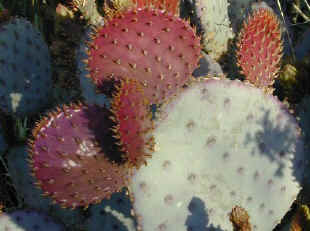
Opuntia
This page is devoted to Opuntias, with
some of the most beautiful flowers in the cactus world! The genus
Opuntia, here, includes the padded types (prickly pears), the cylindrical
types (chollas), and the club stemmed types (club chollas).
Opuntias are an easy group of cacti to grow, and are the
gift that keeps on giving. They grow in sections, any of which can
be removed and rooted to start a new plant. We send unrooted
cuttings and the difference in price reflects two things: one, the overall
size of the cuttings and two, the rarity of that type. In some cases
we may only have a few pads available for sale. The prices listed
are for a single, unrooted pad.
These are all being grown outside here in Tucson (26°F to
110°F), with just a few in protected areas. Any variation on this
temperature tolerance will be mentioned with the particular
species.
Species List |
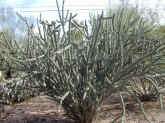 |
Opuntia
acanthocarpa
This southern Arizona species of cholla gets to 5
or 6 feet tall and normally not as wide. The flowers vary from
yellow to red on this species. My clone is red. The name
'acanthocarpa' means 'spiny body', referring to the fruit. |
$4.00 |
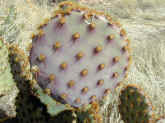 |
Opuntia
aciculata
Clumps to 3 feet tall and several feet wide, with
yellow flowers. From southern Texas and northern Mexico. |
$5.00 |
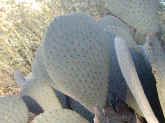 |
Opuntia
basilaris
Beaver tail cactus occurs in sandy soils of the
Mohave and western parts of the Sonoran desert. It makes a low clump
to several feet across with beautiful rose-pink flowers. |
$5.00
|
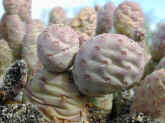 |
Opuntia
basilaris v. aurea
This miniature form of the
species makes small, low clumps, sometimes with runners. Pads are
less than 2 inches long and about half as wide. Nice yellow
flowers. |
$5.00
|
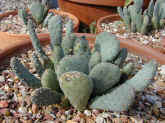 |
Opuntia
basilaris v. brachyclada
This little beavertail
lives on the edge of the desert in south-central California. The
pads are less than 3 inches long and less than half as wide. The
flower is cerise. |
$5.00
|
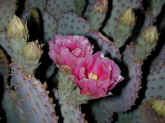 |
Opuntia basilaris X O.
violacea v. santa-rita
This is a very vigorous, fast growing
hybrid to about 2 feet tall and several feet across. Extremely
floriferous. |
$4.00 |
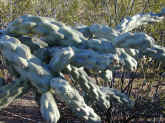 |
Opuntia
cholla
This tree-like cholla occurs throughout
the Baja peninsula of Mexico. The flowers are pink. This
species is probably damaged below the mid twenties. |
$4.00
|
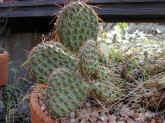 |
Opuntia
erinacea
This plant occurs in Mohave desert
regions up to 7,500 ft., so is very cold tolerant (0°?). This low
spreading species has pink flowers. |
$6.00
|
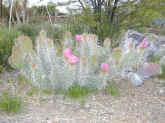 |
Opuntia
erinacea v. ursina
The 'Grizzly Bear' cactus is
aptly named. The plant makes a patch up to several feet across and
can take a lot of sun and cold. |
$6.00
|
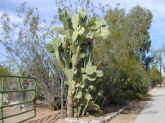 |
Opuntia
ficus-indica
This spineless tree-type prickly pear can get over
15 feet tall in just a few years. It is commonly used in the
southwest for 'nopales', which are the young, soft new pads, cooked and
eaten. The large red fruits are also eaten. The flowers are
yellow. |
$8.00 |
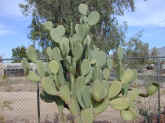 |
Opuntia
ficus-indica Clone 1
This clone of Burbank's
spineless prickly pear has been selected for its desirable fruit
characteristics. It produces large, sweet fruits. It does not
get as large as the normal. The flowers are yellow. |
$8.00
|
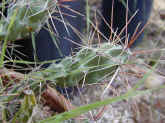 |
Opuntia
grahamii
This club cholla is a Chihuahuan species
from southern New Mexico into Texas and northern Mexico. It is
a mat-forming species to barely over 6 inches tall. The flowers are
yellow. |
$3.00 |
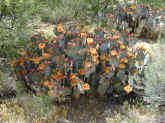 |
Opuntia
horstii
I don't have a clue where I got this name, as I cannot
find it referenced anywhere, but I have had it for close to twenty years
now. This plant is very similar to O. violacea v. macrocentra, but
without the long central spines. |
$4.00 |
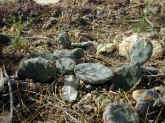 |
Opuntia
humifusa
A creeping, small padded (2.5" by 1.5") prickly pear,
this species forms small patches of pads with yellow flowers. If you
live in virtually any state east of Arizona, save your money and take a
trip to some native habitat and collect a few pads for yourself. My
clone is from Arkansas and is probably cold tolerant to below
zero. |
$3.00 |
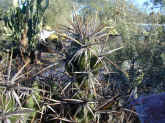 |
Opuntia
invicta
Native to central Baja, this club-cholla
is usually about a foot tall and up to several feet across. It has
yellow flowers. |
$6.00 |
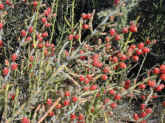 |
Opuntia
leptocaulis
Christmas cholla is so-named because
the small, red fruits are abundant in winter. Native to the desert
southwest, this species forms a shrub to several feet tall and
across. The flowers are greenish-yellow. The name means
thin-stemmed. |
$3.00
|
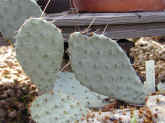 |
Opuntia
macrorhyza
A widespread and variable species from
the southwest into the midwest. Less than a foot tall and spreading,
the roots are fleshy (macro=large, rhyza=root) and the flower is
yellow. |
$4.00
|
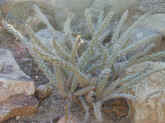 |
Opuntia
marinae
A small growing species to a foot tall
and about as wide. Native only to an area of central to coastal
Sonora, it is rarely offered. 2 to 3 inch diameter creamy flowers
are borne terminally on the stem. The roots are tuberous. |
$6.00
|
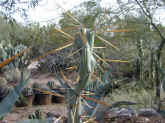 |
Opuntia
molesta
From central Baja California, this
species is shrubby to several feet tall. The flower is yellow purple
and the spines have a distinctive papery sheath. Uncommon in
cultivation and cold sensitive in the low twenties. |
$6.00
|
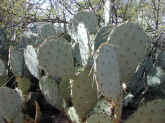 |
Opuntia
phaeacantha
This species is variable, but my clone is native to
Tucson. It gets 2 to 3 feet tall and several feet across and has a
large (3 inches), yellow flower. |
$4.00 |
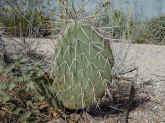 |
Opuntia
polyacantha
A clump forming prickly pear, this species is
native across the west into Canada and is very cold tolerant. The
flowers are yellow. |
$5.00
|
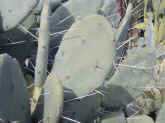 |
Opuntia
quimilo
This tree-like species has central spines
that can get to 5 inches long. It can get 10 feet tall and has
orange-red flowers. From northern Argentina and
Bolivia. |
$6.00 |
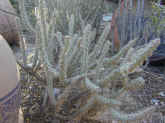 |
Opuntia
reflexispina
A small clumping plant to about a
foot tall and double that wide, this species is very localized from
coastal Sonora, near Kino Bay. The flowers are borne on the ends of
the stems and are yellow. Uncommon. |
$6.00 |
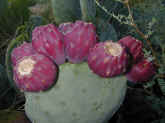 |
Opuntia
robusta
As the name implies, this plant develops
pads up to 18 inches in diameter and in the ground can get over ten feet
tall, with beautiful yellow flowers. Native to the tropical
deciduous forests central Mexico.
|
$10.00 |
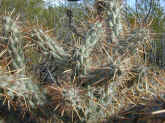 |
Opuntia
rosarica
This species is a tree type Opuntia to
over 6 feet tall. Flowers are yellow. Native to the west slope
of the coastal mountains in northern Baja. Probably damaged at
temperatures in the low 20's. |
$5.00 |
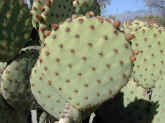 |
Opuntia
rufida
From west Texas and northern Mexico, this small to
medium sized clumping plant has nice yellow flowers. |
$4.00 |
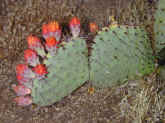 |
Opuntia
stenopetala
A low, creeping species, with strange, bright red
flowers. Native to south-central Mexico. |
$10.00 |
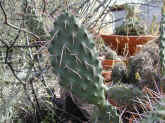 |
Opuntia
sulfurea
This species is a clump forming plant to
one foot. Native to Argentina, it has sulfer-yellow
flowers. |
$4.00 |
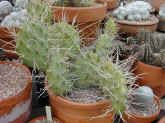 |
Opuntia
sulfurea A-Clone
This is the best clone of this
species that I have seen. The spines are significantly longer and
the pads are much thicker than the normal type. It has a clear
yellow flower. Together, these characteristics make this one of the
most dramatic of all Opuntias. Native to Argentina, this clone is
extremely slow growing, with only a few pads available for sale each
year. |
$25.00 |
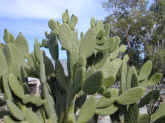 |
Opuntia
tomentosa
Another tree type of prickly pear to
over 10 feet tall. Red-orange flowers and no long spines, but some
small glochids. The plant has a velvety texture (tomentose). I
listed this incorrectly as O. velutina in the past. Native to
southern Mexico and Guatemala. |
$6.00
|
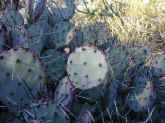 |
Opuntia violacea v.
macrocentra 'Ed Bush Clone'
Variety macrocentra
of O. violacea is shrubby and spreading and has a yellow
flower with a red center. This clone is extremely vigorous and
floriferous. Ed Bush donated hundreds of plants of this clone to the
Arizona Sonora Desert Museum for our annual plant sales. This
variety is native to SE Arizona to W Texas. |
$5.00 |
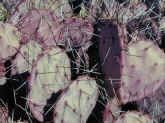 |
Opuntia
violacea v. macrocentra 'Long Spine Clone'
This
clone has much longer spines than normal, with beautiful yellow flowers
with a reddish center. Native to SE Arizona to W Texas, this plant
makes a low growing mound, 2 feet tall and several feet across. |
$6.00 |
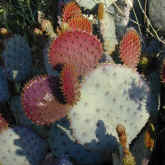 |
|
Opuntia violacea v.
santa-rita
This plant known as 'Purple Prickly Pear'
shows these strong colors in the new growth and when the plant is stressed
from heat, drought or cold. Tree-like in habit, it can get to six or
more feet in height. It is native to southern Arizona and has large,
yellow flowers. |
$5.00 |
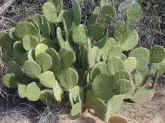 |
|
Opuntia
wilcoxii
Yellow flowers with deep green colored
pads, this species forms clumps to 5 feet tall and somewhat wider.
No long spines, so the pad has a smooth appearance, although it does have
glochids. Distinctive looking plants. Native to coastal
Mexico, from Jalisco to Sonora. |
$6.00
|